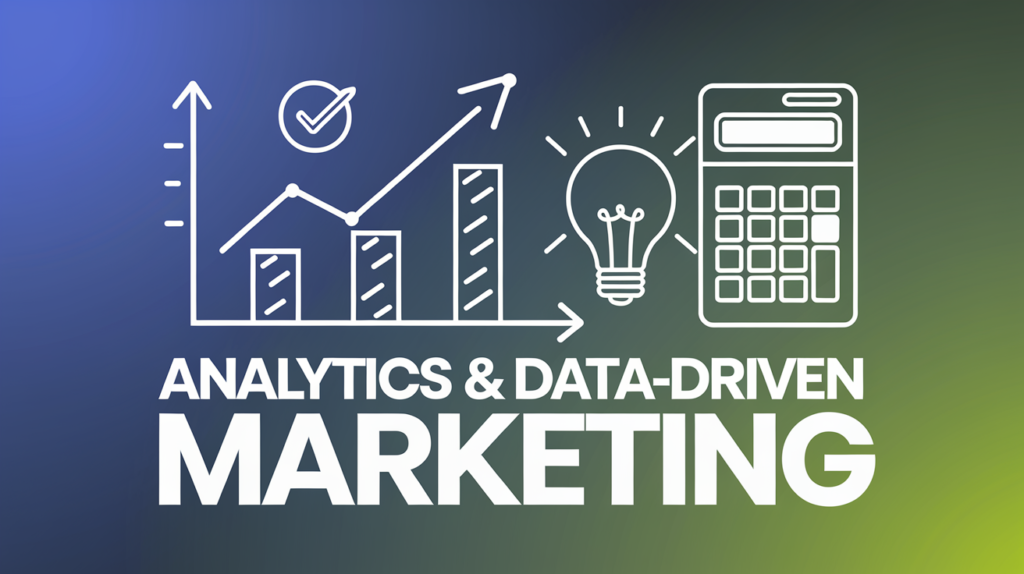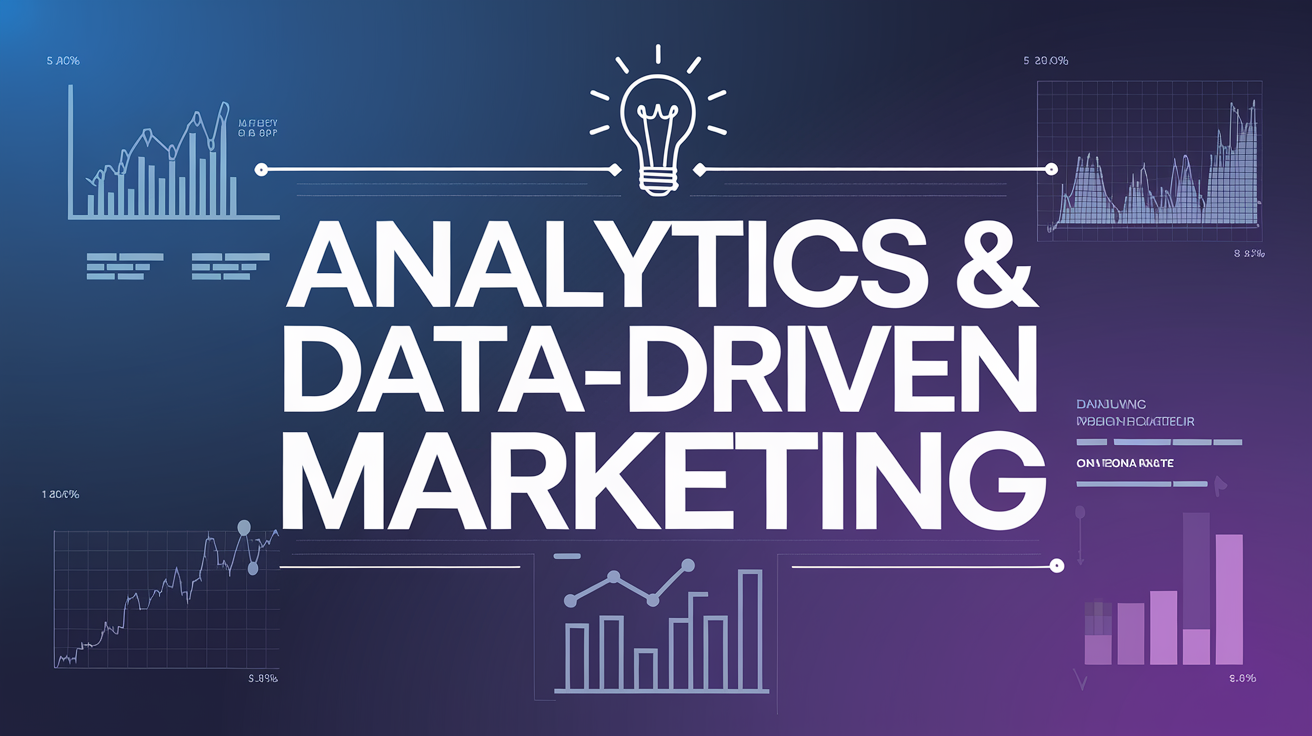Analytics & Data-Driven Marketing
In modern times, companies are using analytics and data driven marketing more and more to get a competitive edge. This strategy uses data to guide marketing plans, maximize campaigns, and provide clients with customized experiences. Analyzing consumer behavior, preferences, and contacts helps firms to make wise decisions that will enhance return on investment, raise involvement, and support long term customer relationship.
Datadriven marketing centers on the gathering and examination of information from many sources including website traffic, social media interactions, email campaigns, and purchase histories. By means of sophisticated techniques including Google Analytics, CRM systems, and AIdriven platforms, marketers can access a lot of data in real time and therefore identify practical insights. For instance, companies can determine which channels produce the most leads, which content appeals to their audience, and which consumer groups yield the most revenue.
One of the primary advantages of datadriven marketing is its capacity to improve personalization. Knowing consumer behaviors and preferences enables marketing professionals to customize messages, promotions, and suggestions to personal circumstances. This extent of personalization not only raises conversion rates but also raises consumer satisfaction. Ecommerce platforms, as an example, recommend goods depending on browsing history, whereas streaming services recommend content matched to consumer preferences.
Moreover, analytics lets marketers accurately gauge campaign success. Clear picture of what works and what does not come from metrics including clickthrough rates, conversion rates, and customer lifetime value. Continuous optimization is made possible by this, so guaranteeing that marketing initiatives match company objectives. For instance, A/B testing enables marketers to try out various methods and determine the best one.
The Power of Analytics & Data-Driven Marketing
In the modern digital landscape, data reigns supreme. Businesses that fail to embrace data-driven marketing risk falling behind their competitors. By leveraging analytics, companies can gain a deeper understanding of consumer behavior, optimize their marketing strategies, and maximize their return on investment (ROI). This article explores the impact of analytics and data-driven marketing, diving into key strategies, tools, and best practices.
Understanding Data-Driven Marketing
Data-driven marketing refers to the process of collecting, analyzing, and utilizing consumer data to make informed marketing decisions. Rather than relying on gut feelings or outdated assumptions, businesses can use real-time insights to create personalized and effective marketing campaigns.
Why Data-Driven Marketing Matters
- Precision Targeting: Data allows businesses to segment their audience based on demographics, behaviors, and preferences.
- Improved ROI: By focusing on strategies that yield measurable results, companies can allocate their marketing budgets more effectively.
- Personalized Customer Experience: With data insights, brands can tailor their messages to individual consumers, fostering deeper connections.
- Enhanced Decision-Making: Analytics provides concrete evidence to guide marketing efforts, reducing guesswork and uncertainty.

Key Metrics in Analytics & Data-Driven Marketing
To effectively harness the power of analytics, businesses need to track specific key performance indicators (KPIs). Some of the most critical metrics include:
- Customer Acquisition Cost (CAC): The total cost of acquiring a new customer.
- Customer Lifetime Value (CLV): The projected revenue a customer generates throughout their relationship with a brand.
- Conversion Rate: The percentage of users who take a desired action, such as making a purchase or signing up for a newsletter.
- Bounce Rate: The percentage of visitors who leave a website without interacting with any content.
- Return on Ad Spend (ROAS): A measurement of revenue generated for every dollar spent on advertising.
Strategies for Implementing Data-Driven Marketing
1. Leveraging Customer Data Platforms (CDPs)
CDPs collect and unify data from various sources, providing a comprehensive view of each customer. This helps businesses create personalized marketing campaigns that resonate with their audience.
2. A/B Testing and Experimentation
A/B testing allows marketers to compare different versions of a campaign to determine which performs better. By continuously testing elements such as headlines, images, and calls-to-action, brands can optimize their strategies for better results.
3. Predictive Analytics for Future Trends
Predictive analytics utilizes historical data and machine learning algorithms to forecast future consumer behavior. This enables businesses to anticipate market trends and proactively adjust their marketing efforts.
4. Marketing Automation and AI
Artificial intelligence (AI) and automation tools streamline marketing tasks, from email campaigns to social media scheduling. AI-powered chatbots and recommendation engines enhance customer interactions, providing personalized experiences at scale.
5. Social Media Analytics for Engagement Insights
Social media platforms offer vast amounts of data on user engagement. By analyzing metrics such as likes, shares, and comments, businesses can refine their content strategies to maximize reach and impact.
Tools for Data-Driven Marketing
Several tools help businesses collect, analyze, and interpret data effectively:
- Google Analytics: Tracks website traffic and user behavior.
- HubSpot: Provides marketing automation and customer relationship management (CRM) features.
- Tableau: A powerful data visualization tool.
- SEMrush: Offers insights into search engine optimization (SEO) and competitor analysis.
- Adobe Analytics: Delivers in-depth customer insights and predictive analytics.
Challenges in Data-Driven Marketing
While data-driven marketing offers numerous benefits, it also comes with challenges:
- Data Privacy Concerns: With stringent regulations like GDPR and CCPA, businesses must ensure compliance when handling consumer data.
- Data Overload: The sheer volume of available data can be overwhelming. Companies must focus on relevant metrics to avoid analysis paralysis.
- Integration Issues: Many businesses struggle to integrate data from different sources into a unified system.
- Lack of Skilled Personnel: Effective data analysis requires expertise in analytics tools and methodologies.
Future Trends in Data-Driven Marketing
As technology continues to evolve, data-driven marketing will undergo further transformation. Key trends to watch include:
- AI-Powered Insights: Machine learning will enhance predictive analytics, enabling businesses to make even more accurate marketing decisions.
- Hyper-Personalization: Brands will leverage real-time data to deliver highly tailored experiences to individual consumers.
- Voice Search Optimization: With the rise of smart assistants, optimizing for voice search will become crucial.
- Blockchain for Data Security: Blockchain technology may play a role in securing customer data and enhancing transparency.
Conclusion
Analytics and data-driven marketing have revolutionized the way businesses connect with their audiences. By leveraging data insights, brands can create more effective marketing strategies, enhance customer experiences, and drive higher ROI. However, the key to success lies in continuously adapting to new technologies and ensuring ethical data practices.
FAQs
1. What is the biggest advantage of data-driven marketing?
The biggest advantage is precision targeting, allowing businesses to reach the right audience with the right message at the right time.
2. How does AI contribute to data-driven marketing?
AI helps by automating tasks, analyzing large datasets, and providing predictive insights to optimize marketing strategies.
3. What are the best tools for marketing analytics?
Some top tools include Google Analytics, HubSpot, SEMrush, Tableau, and Adobe Analytics.
4. How can small businesses implement data-driven marketing?
Small businesses can start by using free tools like Google Analytics, leveraging social media insights, and implementing basic A/B testing.
5. What are common mistakes in data-driven marketing?
Common mistakes include focusing on vanity metrics, neglecting data privacy laws, and failing to integrate data from multiple sources.


Post Comment